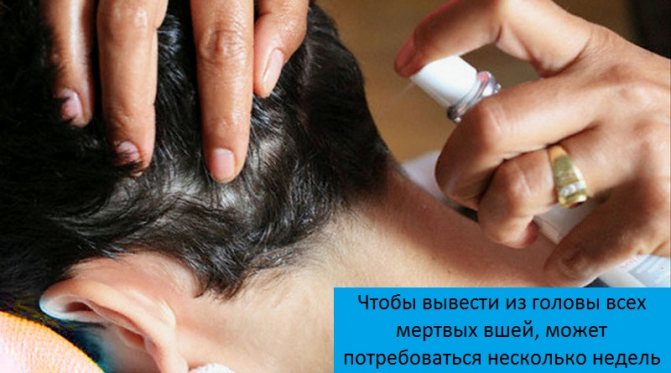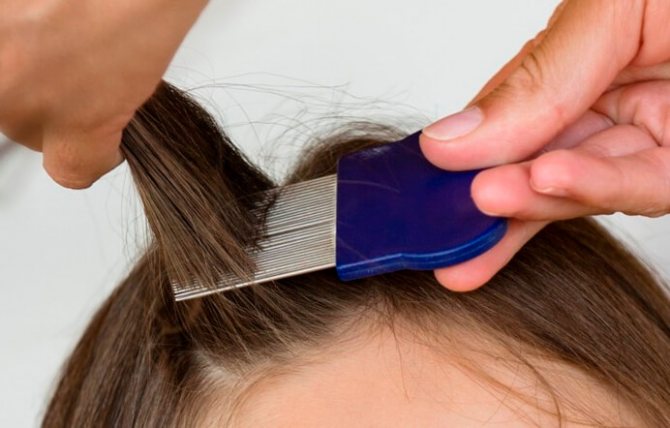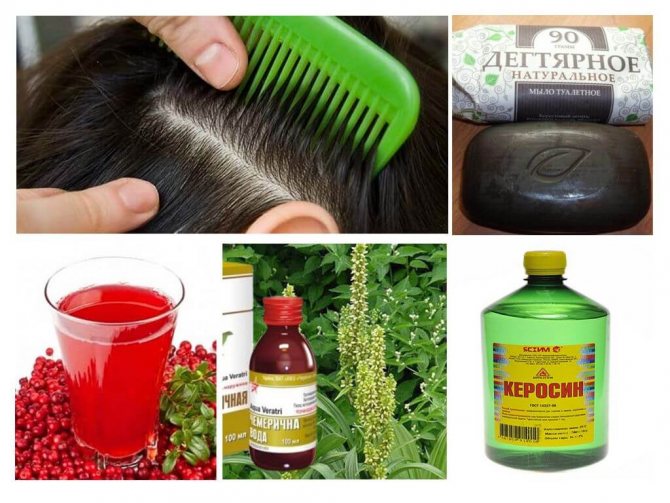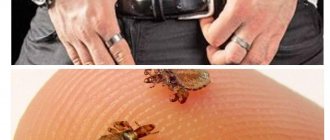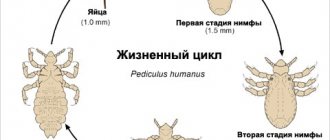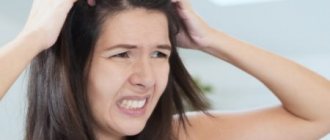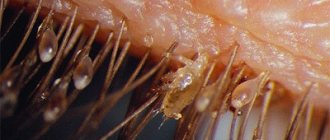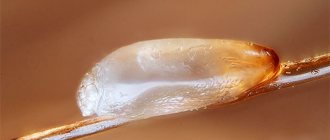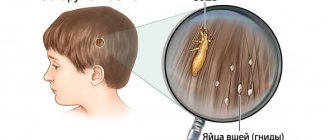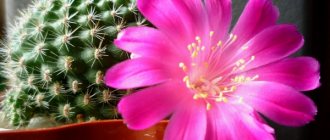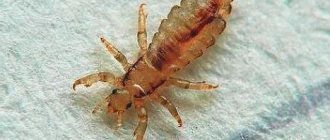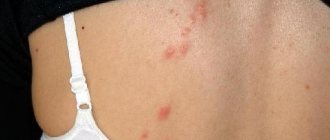Potravin / Lice / Differences between dry nits and live ones
2379
Most of the anti-lice drugs kill sexually mature lice, but they almost do not work on eggs. It is more difficult to deal with them. It is necessary not only to kill the embryos, but also to destroy the sticky substance with which they attach to the hair, and only after that the dry nits are removed from the head.

Dry nits
Where are
Although lice can move up a person's hair while laying eggs, nits may not be found along its entire length. Usually, the female crawls only two or three centimeters from the skin, so eggs are usually found at this distance. On the head itself, nits are very rarely deposited (it happens if only one falls and is fixed on the skin).
By the way, lice usually leave eggs on new hair, that is, if one already has them, then the other will most likely be chosen. This increases the chances of full development and prosperous existence of all individuals. Although if lice are found on the head in large numbers, then nits can literally fill all the hair, several eggs will be found on each.
It is easiest to find them on straight and dark hair, as the eggs will stand out due to the dark color. If the curls are light and, among other things, curly, then the search process will become noticeably more complicated. And in this case, a thorough examination will allow to identify the infection. You should take a comb with often spaced teeth and comb the hair well, dividing it into small strands.
Are nits transmitted
Many are interested in the question: can nits be transmitted from one person to another. If lice can move, although not as actively and quickly as, for example, fleas, then nits remain motionless on the head of one person during the entire period of development and cannot get to another. But nevertheless, with very close and prolonged contacts, the fallen hair with an egg laid on it may accidentally end up on the body of another, and then it is likely that infection will occur. But still, this is extremely rare.
How to get rid of
If lice can die under the influence of toxic insecticidal substances, then nits are resistant to most of them, since the shell is quite dense, and the insects that are in capsules and develop in them do not feed (that is, the active components of the funds simply cannot get into the digestive tract ).
And that is why the fight against them is quite difficult. It is also extremely difficult to remove them mechanically, since the capsules are firmly attached to the hair. But still there are drugs with the so-called ovicidal effect, that is, those that affect directly the nits
When fighting these parasites, it is important to know one thing: when squeezing the nits, you will hear a click if it is still alive. That is, live nits click
Now you know what nits on the head look like, so you can surely detect and exterminate them.
Capsules from the embryo - what is it?
There are several types of lice in nature, but the most common louse is the head louse. Getting on the head of a person, she begins to quickly lay her eggs - nits, attaching them to the hairs with her glue.Read more on our website about the incubation period of nits and the reproduction of lice.
The nit itself develops a week, and after three (on average), the number of adults, sexually mature individuals is added. One such a prolific mother can put aside up to five nits per day, and she lives for about a month.
Often, even after careful treatment, when there are no longer living insects in the hair, shrunken capsules remain, empty bags that firmly hold onto the hair. These are dead nits. If any are found, then there were lice that have already hatched.
Sometimes, these are full eggs with dead embryos that died without hatching. The fact is that for development they need a certain temperature and environment, and if they died, it means that they found themselves in uncomfortable conditions for themselves.
The future larva may also die from treatment with special means, but most drugs are fatal only for hatched individuals.
The nit is the egg of the parasite. Its embryo lives in a mucous capsule that envelops the hair and is firmly held on it. Dry nit - an egg without a larva, remains in its place, after the release of a young louse for a long time.
Symptoms
Symptoms of head lice include:
- Intense itching in the scalp. Over time, swelling may appear on the surface, which turn into scratching and open sores.
- On closer inspection, you can see traces of insect bites on the skin. They look like needle punctures with redness around the area. Also, in some areas, small spots of gray or gray-blue color appear.
- In the occipital and temporal regions, as well as behind the ears, scaly plaques form, which eventually begin to get wet.
However, the most reliable signs that allow you to diagnose lice and nits at home are the following:
- The presence of nits - head lice eggs, which attach to the hair shaft at the bottom.
- The presence of the lice themselves - small insects that move through the hair and scalp.
The life cycle of lice is about a month, and about two to three weeks pass from the moment the female hatches to the first clutch. Accordingly, the course of treatment for pediculosis can be considered complete only if it has been carried out for at least a month, and a month after the start of treatment, neither adult insects, nor lice larvae, nor nits (lice eggs) are found on the head.
Also, when trying to remove lice and nits at home, it is worth remembering that lice and nits are, in fact, very different from each other. What works on lice is completely harmless against nits, and vice versa.
What to do if lice appear?
When lice were found, first, disinfestation is mandatory, to which the following items should be subjected:
- Linens;
- Household items;
- Clothing;
- Everything else with which the sick person was in contact.
Physical pest control means washing at the highest possible temperature. The effectiveness of this method directly depends on how long the exposure to a certain temperature will be.
The minimum indicator should be 60 degrees - with it, the clothes should stretch for at least half an hour. In a wet state, you will have to walk it with a hot iron.
If things are forbidden to wash at such a high temperature, they need to be frozen, however, this method is not very effective. It is used only if other methods of exposure are not possible to use.
Lice usually calmly relate to low temperatures, falling into suspended animation. At a temperature of -20 degrees, they are able to survive for a day.
When several people get infected, it is advisable to resort to chemical pest control.For this, various kinds of powders, chemical compounds, shampoos, aerosols, and so on are used. They act in about the same way - they dissolve the skin of parasites, which leads to their death, however, over time, lice can adapt to such substances.
Signs of the difference between dead and living nits
Their size is 1-1.5 mm. This capsule protects the lice embryos from external influences. It is attached to the hair with an adhesive that is very difficult to remove mechanically.
Medical anti-lice shampoos, sprays, etc. do not harm eggs, because do not destroy their shell and sticky substance. Therefore, the tactics of dealing with lice embryos should be different. They use acidic and alcohol-containing agents, special oils, etc. And only after the use of such drugs can you observe progress in the treatment of head lice.
With the use of means that destroy lice eggs, the number of dead nits increases. For the effectiveness of therapy, it is necessary to distinguish them from still living embryos.
It can be determined by the following criteria:
- dead individuals are surrounded by a less elastic and convex shell;
- in dead embryos, the shell is dull, whiteness is present;
- The dead nit crunches and clicks.
If it is possible to look at the eggs of lice under a microscope, then you can see the destroyed shell and the killed larva.
How to understand that nits are dead? In appearance, despite its tenacity, a dead nit differs from a living one in several ways:
- the dead has a dull gray or whitish color;
- when crushing dead nits, there is no characteristic click.
We suggest that you familiarize yourself with What analysis of feces you need to take with diarrhea
To check whether she is alive or not, she is removed from the hair by hand or, using a comb, is placed on the nail of one finger and pressed strongly with the other.
Development features
After postponement, development begins. It takes about 5 or 8 days, everything will depend on the specific environmental conditions. So, at the optimal temperature, which is 32-33 degrees, nits can develop in the shortest possible time. If the temperature drops below 20-21 degrees or rises above 39-40 degrees, then the development is suspended, that is, it stops for a while.
The development process inside the egg, as well as the exit from it, can also be called amazing. So, when an insect matures completely, it cannot immediately leave, since it still has little strength, and the shell is very strong. But it opens the lid of its cocoon and begins to breathe actively. As a result, air fills the body and enters the digestive tract, and then exits through the anus.
As a result, a louse develops from the nits. And already lice begin to actively bite through the skin in search of food. For this reason, a person develops severe itching. The head itches from head lice. The person begins to scratch the bite sites, severe irritation appears. To avoid this, one should begin an active fight against them already at the initial stages of insect development.
What is the threat?
By themselves, immature nits do not pose a threat, with the exception of the unattractive appearance of the hair and white formations in them. But when the louse has begun its parasitic life, symptoms appear that can significantly impair the quality of daily life. These symptoms include:
- almost constant itching of the scalp;
- infection of scratches and wounds, their infection and suppuration;
- sleep disturbance;
- inability to concentrate;
- irritability, nervousness.
Sometimes typhus or age-related typhus can become a complication of head lice. Health-threatening infection of damaged skin after a lice bite occurs as a result of contact with the waste products of parasites, that is, with fluids and feces.
How to remove dead nits from hair?
Having got rid of living parasites and destroying the embryos, you should not expect that dead nits will fall off by themselves. This can take a very long time, and there is no guarantee that they are all inanimate. Perhaps there are viable ones among them, and if you overlook them, you can expect the emergence of a new generation of the unbearable parasite. It is better to deal with their removal, even with your hands.
The dead nit itself will not fall off immediately. Even clean and well-groomed hair will look untidy if whitish capsules at the roots are visible through it. Be sure to delete!
How to get rid of dead nits? You can remove dead nits with a special comb. Desirable wide. There are many of them, from conventional to electric. You can buy any of them at almost any pharmacy. An ordinary comb, due to its structure, will not help much.
It is necessary to follow all the steps correctly, only then the head will become clean and free of lice and their eggs.
- Divide your hair into even strands.
- Comb out each strand separately.
- Transfer the processed strand to the side, securing it with a hair clip or a clip so that it does not touch the untreated area.
- Scratch over a sink or spread cloth.
- Brush out carefully daily for 10 days.
- Every day during this period, wash your hair with a special agent.
- To process combs, hairpins, brushes, if they were used - rinse with running water with laundry soap.
- Wash cloth, napkins and gloves in hot water (50 degrees) or burn them.
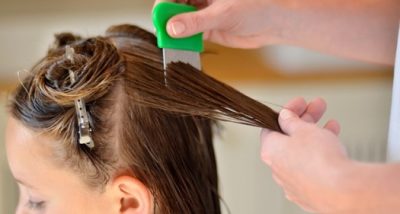

To make it easier to pluck the nit from its familiar place, with the help of special anti-pediculosis agents, they soften its shell. These can be special pediculicidal shampoos, or sprays for lice and nits: Para-Plus aerosol, Pedilin, Medilis Malathion emulsion, Pedikulen-ultra, Paranit, Nyuda, or anti-pediculosis ointments - Benzyl benzoate and Sulfuric acid.
Read the instructions before applying chemical antiparasitic agents.
Sometimes they use centuries-old folk remedies for lice and nits in the fight against the tenacity of nits: cranberry juice, kerosene, vinegar, hellebore water. Sometimes hydrogen peroxide, hairspray, dichlorvos, hair dye, dust soap, tea tree oil are used.
ATTENTION! Kerosene and vinegar can burn the scalp. Chemerichnaya water can cause an allergic reaction. Peroxide changes the natural color of your hair.
Read helpful articles about nits on our website:
Currently, effective drugs have been developed that act on adult parasites, nymphs and eggs. But even after treatment, dead eggs remain on the hair. They should definitely be removed. They will naturally leave the head only together with the hair shaft.
Dead nits do not pose a danger to the health of a child and an adult. But this is a foreign protein that can cause an allergic reaction in the skin or the respiratory system, since the small particles can be easily inhaled.
Psychological trauma is an additional danger. Other children, seeing the eggs of the parasites in the child's head, may tease and insult him. In addition, not a single drug provides a complete guarantee of the death of all individuals and eggs of the parasite.
By removing dry nits, you reduce the likelihood of lice surviving and disease recurrence.
With multiple lesions, the hair of a patient with head lice looks as if they were sprinkled with small croup. Nits are visible to the naked eye, so others will avoid it. Proving to people that nits are dry and safe is useless.
What's the bottom line?
The conclusion from the comparison of methods is as follows.
The most effective, safest and most reliable method is combing treated or damp hair; it is the cheapest as it equals the cost of the comb. Although it is better to add a magnifying glass here, it will be possible to quickly find and neutralize insects.
This method will have to be resorted to even using other options, becauseonly combing out will effectively get rid of lice and nits.
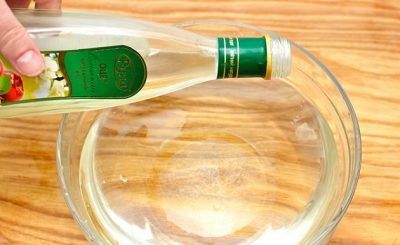

Regardless of which way of fighting you choose, the main thing is to remain calm.
How to get rid of parasites
Having figured out what dead nits look like, you need to understand how to get rid of them correctly. A proven method is brushing. But the use of a comb has a certain nuance. Working with it is laborious and requires daily manipulations.
If there are dead parasites, then there are living ones. Therefore, a person will be completely cured when neither one nor the other will remain on his head. This can be done in different ways.
Hair treatment
The most effective and common way to get rid of lice and their eggs is treatment with anti-lice preparations.
Due to its composition, the drug contributes to the destruction of parasites, destroys the shell of eggs. Some products are less aggressive, because contain acids that break down the sticky substance.
The most popular drugs in the fight against head lice are:
- Pair Plus;
- Pedilin;
- Paranitis;
- D 95.
You need to use the funds according to the instructions for use, having previously familiarized yourself with the side effects and contraindications. If, when applying a medication to the scalp, itching or redness appears, you need to urgently wash off the medicine and go to the doctor.
Remove nits from the scalp with an anti-lice comb. You can buy it at the pharmacy. Such devices look like ordinary combs, but they are made of medical steel and have teeth closely spaced to each other.
This device is versatile in use. It is used to remove both live and dead nits. It is used for both long and short hair. The use of combs has no contraindications and age restrictions.
How to remove parasites:
- Wash your hair with an anti-lice shampoo.
- Dry with a towel.
- Divide hair into strands (if long).
- Carefully go through the strands with a comb, from the roots to the ends of the hair.
- The collected lice are removed on a white cloth or thick paper.
- For more efficient gliding of the device on the scalp, the comb is treated with conditioner after each pass.
After the end of the procedure, dead nits and lice are disposed of. The head is washed again. The parasites are combed out daily, 7-10 days.
For a more effective treatment for head lice, it is better to combine hair treatment and combing. The first procedure will remove the sticky substance of living eggs and destroy their shell, and the second will help remove already dead individuals from the hair.
For owners of long hair, you can also use a regular iron. It will help get rid of dead lice embryos and still living parasites. The effectiveness of the device is determined by the provision of a high temperature, due to which the adhesive dissolves and the hard shell of the eggs bursts.
We offer you to familiarize yourself with Dry nits on hair: how to distinguish between dead and living, how to remove
To make the use of the iron most effective, it is important to adhere to some rules for removing lice and nits:
- Wash your hair thoroughly, preferably with an anti-lice shampoo.
- Comb long hair, divide into strands, fixing them with elastic bands.
- Treat the hair with a thermal protection cosmetic.
- Use a flat iron gently from the roots of the scalp to the ends.
- Pass the device slowly through the hair.
After the procedure, you need to comb out the remaining parasites with an ordinary comb with rare teeth. It is better to do this over the bathroom.
After treatment, dead larvae remain on the hair. To understand whether the lice larvae are alive or not, you should press on them with your fingernail. If you hear a characteristic crunch, it means that the future parasites have survived. Dead nits can be recognized by their shape: they are not convex, but flat.
Hair treatment
Anti-lice products kill lice
Choosing the right way
The basis of any choice is the degree to which each method suits a particular patient.
For example, a person with dry and brittle hair is better off not using vinegar. It will dry out your hair even more and will also cause huge damage to damaged hair.
We suggest that you familiarize yourself with: How to deal with the scale insect on orchids
One of the safest treatments is the use of cranberry juice. Firstly, it is a completely natural remedy that will not harm your hair in any way.


Secondly, the juice of this berry to a very large extent dissolves the glue with which the nits are glued to the hair. Thirdly, cranberries contain a huge amount of useful trace elements that will benefit the head.
The second most effective way to dissolve nits glue can be called vinegar. Basically, it is a corrosive acid diluted with water. Like any other acid, vinegar eats away at the connective enzymes that make up the glue and the nit capsule itself.
When choosing a remedy, it is worth paying attention not only to the degree of danger of a particular remedy, but also to the state of the scalp.
If it has wounds from insect bites, irritation or any other damage, then you should first use softer products that will slightly improve the condition of the skin:
- tar soap;
- laundry soap;
- boric or sulfuric ointment;
- other.
If the state of health allows, you can turn to less gentle means, such as hairspray or the same vinegar.
The use of frankly harmful agents, such as dust, kerosene or mercury ointment, is not recommended at all. Although their effectiveness is very high, the harm that can be done to yourself or others can be much greater.
The mechanical method of getting rid of parasites is the cheapest, but at the same time the most time consuming. It completely excludes the use of any drugs.
You need to stock up:
- patience;
- a thick scallop (preferably with a special one);
- a good lamp;
- magnifier;
- find an opportunity to calm and relax the child.
For example, include your favorite cartoon.
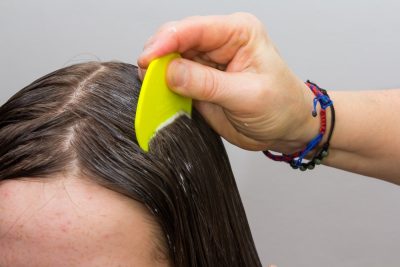

The shorter the hair and the sooner a child is diagnosed with a problem, the easier it will be to cope with it.
After all, one louse lays 4 nits a day!
- To begin with, the child's head is washed with regular shampoo. Lice will be a little sleepy for a while.
- Then, if the length permits, fix the hair with an elastic band, separate one strand at a time and comb from root to tip (very important).
- Collect clean strands under a separate hair clip. After each strand, do not forget to wash off nits and lice from the comb.
- It is better to do this under running water, pushing the teeth of the combs with your fingers. Put a towel over the child's shoulders to avoid getting lice and nits on the clothes.
The very procedure of combing out must be carried out in the bathroom, so that it is easier to flush the "uninvited guests" down the drain.
It is possible to completely get rid of lice and nits in one day at home if you do everything strictly according to the instructions, go through every hair and comb out all the nits.
Using a magnifying glass is a device that accelerates the process, because the nits are clearly visible through the magnifying glass.
But, after a couple of weeks, it doesn't hurt to take a few minutes and look at the child's head to make sure everything is in order.
We must not allow even one nit to remain on the hair!
Important: the hair must be wet before combing, it cannot be dried with a hairdryer, otherwise the effect will be weak.
Review from the son's mother: Once I noticed that the son often scratches his head literally, tears it apart. I paid particular attention to this when he went to the hairdresser.
I thought dandruff or other reasons, and then looked at my head. And immediately success - I found 3 lice and a lot of nits. I suspect that he contracted it, it was in the hairdresser.
It so happened that I couldn't get to the pharmacy and buy the product after work, there was no comb, so I sat with a comb every day for 30-40 minutes a day in the evening.
As it turned out, it was a problem to buy an ordinary comb, then I found it in online stores, but they were not available there either, I was saved with an ordinary comb with frequent small teeth. I did this for 3-4 days at first and still found 1-2 lice, and on day 4, only dead nits remained.
Now, as a preventive measure, I am still looking at the child's head.
I think that it is easy to get rid of lice and nits, 2 things helped us:
- I spotted them immediately, the same day or the next;
- the child has a short haircut, although the upper part of the hair is from ear to ear, such a hat.
He flatly refused to have a haircut, so it happened.
The knowledge from this article helped a lot, I knew many of the nuances and therefore began to immediately apply all the knowledge, although I did not get to the means for lice.
The mechanical method was ideal for me, since it is harmless and does not require any money at all, only time, a lamp and a comb. My son lay quietly for 20-30 minutes, he liked the process of combing, I tried to cause him minimal pain or discomfort. I pulled out the nits with my fingers.
Getting rid of nits on long hair quickly isn't easy, so be patient. The most effective is the mechanical method, which involves combing out. Our ancestors used to pick nits by hand, but today there are many aids designed specifically to combat parasites.
Combs with fine teeth are sold in pharmacies. The distance between them is small, and with high-quality combing, not a single nit will be able to stay in place. You can also use a homemade scallop, but usually the teeth are not so closely spaced in them, and some eggs go unnoticed.
It is important to know how to comb your hair correctly so that you don't miss a single nits. To do this, you need to divide them into thin strands and carry them with a comb along each, heading down from the hair roots.
It is difficult to cope with this on your own, because when combing out, you need to carefully examine the strands, especially the root area.
The duration of the procedure depends on the length and thickness of the hair. On average, it takes from two to 5-6 hours. To consolidate the result, combing must be repeated every day for a week. Despite the inconvenience and duration, the mechanical method of removing nits from the head has the following advantages:
- is the most effective;
- there are no contraindications;
- there are no side effects;
- can be used to combat parasites in a child.
Duration of combing course
How to get rid of dead hair nits at home? It may not work to remove nits from hair all at once the first time. It is best if they are combed out for 12 days to prevent the re-development of lice. Thick hair should be checked especially carefully and combed out 2 times.
In order not to get infected yourself, it is better to insure yourself. Gloves and a gauze bandage and a white cloth spread under your head will help prevent this. In the future, try to carry out checks and examinations of the hair and body for the presence of lice more often.
At the slightest suspicion, it is better to carry out processing and removal, so that again you do not have to perform an unpleasant operation to remove dead, but very tenacious nits from the hair.
If head lice was diagnosed


Live and dead nits and their larvae are removed using folk methods. With the use of scalp treatment with special products and a combing procedure.
List of foods to help dissolve the sticky substance:
- Chemerichnaya water. The pharmacy is used according to the instructions.
- Hydrogen peroxide. Dilute with water 1: 3. Apply to hair and keep under a plastic bag for 30 minutes.
- Lemon juice. Before application, dilute with water 1: 3.The agent is kept on the head for 30-40 minutes.
- Cranberry juice. Eliminates the sticky substance of live lice eggs, does not damage the hair structure. Keep the medicine on the head for 40 minutes.
- Vinegar. Dilute 1: 2 with water. Withstand on the head for 15 minutes.
Each of these products is less aggressive to the hair and scalp than anti-lice medications. But before using them, you still need to consult a doctor to avoid allergic reactions.
What nits (lice) look like in humans
How to remove lice and nits on hair
There are very strong insecticides that have an ovicidal effect not only on lice, but also on nits. Preparations, where the active ingredient permitrin is in the composition, destroy the larva inside the capsule. The capsule remains empty, but continues to be on the hair, this gives the person an untidy look.
The special nit and lice comb is very easy to use and safe. With this device, nits and adult parasites can be removed even without the use of chemicals. And environmental friendliness is important for removing blood-sucking parasites in children, in pregnant women and in people who are prone to allergic reactions.
In order for the nits, it is necessary to divide the hair into strands, which are then carefully combed from root to ends with a comb. The mechanical parasite removal process is best done over a bathtub or over a light colored cloth. After the completion of combing, the bathtub must be thoroughly washed, and the sheet must be shaken out on the street.
There are a large number of combs on sale. NitFree, LiceGuard, AntiV can be bought at almost any pharmacy. During the purchase of certain pediculicidal agents, the comb can be received as a gift: a device for removing live and dead bloodsuckers is included in the kit. The scallop is used as an independent remedy for parasites, and is used in combination with an insecticide.
In general, you can get rid of lice either in special receivers operated by a sanitary and epidemiological station, or at home. Given the availability of a large number of pediculicidal agents on the free sale, getting rid of lice and nits at home for a child is much easier than looking for a special detention center in your city and going there for treatment.
In addition, the contingent usually "rotates" in such places poorly - these are homeless people and disadvantaged representatives of the population who are not friendly with soap in principle. Therefore, let's figure out how to remove lice at home quickly, reliably and at the same time safely for health.
Methods of influencing head lice are divided, depending on the basic substance, into:
- mechanical;
- chemical;
- mixed - application of the first two methods.
Mechanical methods include:
- shaving bald;
- combing hair with lice combs.
Chemical methods of influencing nits and lice include:
- special means to combat parasites;
- table vinegar;
- kerosene;
- hellebore water.
It is very important to treat head lice correctly, while you need to follow some rules:
- Do not use drugs for nits and lice while they are on the eyebrows or eyelashes.
- Children under 2 years of age are prohibited from using drugs that contain chemical components.
- With great care, pediculosis should be treated for children who suffer from bronchial asthma or other types of allergies.
- Replace the nits medication with another if after the first use the lice have not died, and nits remain on the hair.
- Be sure to comb out the nits after each pest control procedure.
- Do not blow-dry your hair after using antiparasitic drugs;
- It is forbidden to use hair masks, conditioners after removing lice.
- After hair treatment with antiparasitic agents, you do not need to wash your hair for 2 - 5 days.
The fastest result can most often be achieved by combining mechanical and chemical methods. Decide which options for the treatment of lice to choose, based on the degree of development of the disease, the length of the hair and the area of the lesion. For example, it is easiest for men to just shave their heads, but for girls with long hair, this method is unlikely to work - here you will have to spend both time and energy to remove lice forever.
For adherents of natural remedies for head lice, there are some traditional methods of getting rid of lice and nits. These products are perfect for young children, whose skin is very delicate and susceptible to chemical attack:
- cranberry juice. Cranberries contain a lot of citric and quinic acid, which can eat away the sticky substance, the nits shell itself, as well as the larva. The essence of its use is to apply cranberry gruel to the head and stand for 20 minutes. After that, the "mask" should be thoroughly washed off with running water. You need to carry out the procedure for 5-7 days, combining with combing to completely effectively get rid of parasites;
- vinegar compress. Dilute 1 to 1 with water. However, it is worth remembering that prolonged holding on the head can lead to burns. Therefore, it is very careful to use such a remedy for young children;
The use of kerosene to remove lice and nits on the human head
- kerosene, diluted in half with sunflower oil. Keep such a compress for no more than 15 minutes. It should be remembered that kerosene is flammable. Therefore, it is better to give preference to safer means;
- mask of onions and 2 yolks. This gruel must be kept for about 2 hours, then thoroughly rinsed with water with the addition of citric acid.
If there is a lice infestation, it is worth taking immediate steps to help limit the spread of hair lice to other people and to get rid of the parasitic disease.
The activity of the parasites themselves delivers a lot of discomfort:
- itching in the area of bites, as a result - scratching;
- slight flaking of the scalp;
- unkempt appearance and unpleasant smell of hair due to the presence of nits on the hairline;
- gray-blue spots on the affected skin;
- in rare cases - an increase in the cervical and occipital lymph nodes. Nits are very small in size, so even combing with special combs will have to be done several times
We suggest that you familiarize yourself with What is AIDS and HIV (symptoms, how it is transmitted, diagnosis, treatment)
However, the listed inconveniences are not the worst outcome for an infected person. The most dire consequences can result in diseases that lice are able to transfer to their victims. Diseases such as typhus and relapsing fever, Volyn fever, as well as other febrile illnesses caused by rickettsioses (parasitic microorganisms) can become a real tragedy for humans.
Dandruff concept
A syndrome described in medicine as increased exfoliation of scalp particles over a long period of time. The pathological condition is caused by a violation of the processes of desquamation of the upper stratum corneum of the head, due to improper functioning of the sebaceous glands.
Scales of various shapes cover the hair along the entire length, but most of all accumulate in the upper part. They are especially well visible on dark curls. The head is covered with small particles that easily fall off when combing, touching with hands.
Pathology is not contagious, unless it is caused by the multiplication of pathogens. Some serious dermatological diseases are accompanied by dandruff and are transmitted through exfoliated scales of the scalp.
On a note!
Dandruff occurs on dry skin due to a lack of natural oil. It is accompanied by itching, a feeling of tightness of the scalp, dry hair, split ends. On a greasy cover due to excessive secretion of fat, the multiplication of microorganisms.Hair grows oily in 2 hours after shampooing, sticks together, looks unkempt.
How to check if insects died after treatment or not
Got head lice? Have you treated your head with a preparation and now want to know if you need to repeat the treatment? To do this, you need to check whether the causative agents of the disease have died. How can you check this?
They say that dead parasites should not click, and living ones - click when pressed with their nails. Is this really so and why do living insects click? Do you want to know?
Then here's the answer: the surviving parasites really clink because they have a shell that bursts when pressed, and inside there are organs, fluid and other body components that form a cavity. Simply put, a living parasite can be compared to a soap bubble or a balloon.
But the characteristic sound when pressed is not emitted by all harmful insects related to head lice. As a rule, only viable nits will clack. Lice and nits actually have a lot of differences.
Here is the answer to the question: should lice or fleas in adult form click. Therefore, we can immediately answer the main question of the article: do dead lice click? Unfortunately, no, as well as living ones, therefore, the death of the parasite cannot be determined by the sound.
And how then to check the effectiveness of treatment after hair treatment with an anti-lice remedy? In fact, you can do this, and below I will tell you exactly how.
To check whether the causative agents of head lice died after treatment or not, you need:
- take a special anti-lice comb (sold in pharmacies, often comes with an anti-lice drug, has a dense row of teeth, is made of durable plastic or metal, which is better, since the metal can withstand impressive loads and allows you to comb wet hair with high quality);
- immediately after processing, comb each strand with this comb (after you wash off the preparation, you need to lightly dry your hair with a towel and comb with the above-described comb, and in order to facilitate the process, you can apply any balm or thick mask);
- after each strand, wipe the comb with a napkin (this way you remove the insects from the comb, so that they do not fall on other strands of hair during combing);
- take a close look at the insects and their eggs on the napkin (you can even wiggle them with a toothpick).
The deceased causative agent of the above-described disease will not crawl, but may twitch convulsively. The eggs, in turn, if dead, then will not click when pressed and, conversely, will be if they survived.
You can try to crush a dead and a living nit to feel and hear the difference. Do the same with an adult parasite, and then you yourself will understand whether dead lice click (no, like live ones).
By the way, distinguishing the causative agent of head lice from a flea is also very simple: the flea jumps, but he does not.
Dead insect eggs do not clack when pressed because their shell breaks down and they become dehydrated.
This is how almost all modern anti-lice drugs work: they destroy the membrane, paralyze the nervous system and provoke dehydration.
This phenomenon can be compared to a ripe, juicy, fresh and dry, sluggish fruit.
We carry out a preventive examination: how much should be done, how exactly?
After 4-7 days after the first treatment, be sure to carry out a preventive examination:
- comb dry hair with a regular comb;
- divide into small strands;
- carefully examine each strand, especially on the back of the head, near the temples, behind the ears;
- make sure there are no parasites in any form (even nits should not be).
So you will understand that all the parasites are destroyed, or that the treatment will need to be repeated. By the way, if, after the first etching, clacking nits remain on the hair, then they will surely hatch and head lice will start again.
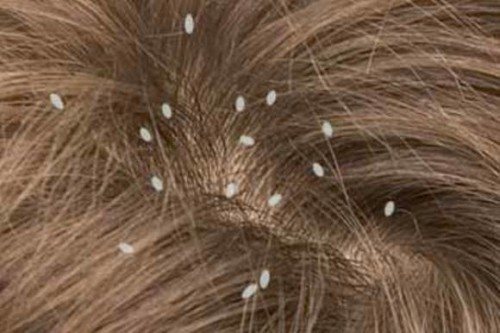

This is why combing out parasites is so important: this way you will definitely remove them from your hair, thereby preventing the recurrence of the disease.
Prevention is always better than cure
As with any disease, there are specific measures for the prevention of head lice. To keep your child free of lice, parents should instill in him personal hygiene skills.
It is important to tell your baby about personal items that cannot be shared even with relatives.
So, what to do to prevent lice from getting in, what should be the prevention of head lice?
The following rules must be observed:
- Do not use other people's combs and hats.
- Do not touch strangers with hair - you always need to keep a certain distance.
- Do not drive a child with loose hair - it is for this reason that girls are more likely to catch head lice.
- Regularly examine the child's head for head lice. If children with this disease are identified in kindergarten or school, an examination is carried out every week.
Revealing head lice in a child is an unpleasant fact that you don't want to talk about with strangers. But what if lice are found? It is more correct to inform the teacher about this, this will be the best measure of head lice prevention in relation to other people.
Also, for prophylactic purposes, you can use various drugs that protect against infestation with head lice. These can be lavender and tea tree essential oils added to the water to rinse your hair. As well as specialized products, for example, Lavinal prophylactic shampoo for head lice.
To avoid being infected with parasites, it is very important to adhere to the rules of personal hygiene, take a shower regularly, and change bedding and underwear. Try not to use other people's hygiene products: combs, hats, clothing, towels or bedding
When visiting a sauna, bath or pool, always shower thoroughly and use only your own hygiene products. Periodically check the head of your child attending child care. Trains, hospitals, summer camps are a risk group for children. Remember to eat right and maintain an active, healthy lifestyle. Then you will not be afraid of any parasites.
How nits appear
So, as you already understood, lice lay nits in the hair. The female becomes sexually mature a short time after emergence. Such insects are characterized by incomplete transformation, that is, an imago hatches from an egg - an insect that is very similar to an adult, but differs from it in size, as well as in a shell.
It is noteworthy that clutches are carried out throughout the entire life of the insect. That is, after each feeding, the females can lay 3-5 eggs, and per day one individual produces about 10 or 15 (under favorable conditions). The process of egg release is also interesting. The egg begins to descend through the oviduct and moves into the anus.
At the same time, it passes by special glands that produce an adhesive secret. During the exit, such mucus literally envelops each egg, it comes out, immediately comes into contact with the hair, and the secret envelops both it and the hair shaft. The result is a kind of firmly fixed cocoon - these are nits in the hair.
Where do nits come from?
Most often, head lice is transmitted through close contact, during which the louse goes to the next victim. Nits cannot move independently, so this type of infection is less common. This can happen in the case of sharing a comb, hat, invisibility, hair tie.
Children under the age of 12 are constantly in contact with their peers, so the percentage of head lice prevalence in children and adolescents is high. And if one of the students is diagnosed with a disease, it is recommended to undergo treatment for all of his classmates, as well as their families.

